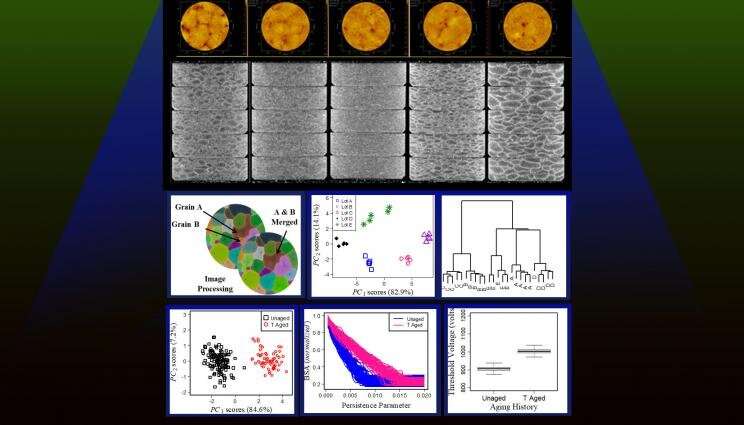AI identifies change in microstructure in aging materials
by Anne M Stark
Lawrence Livermore National Laboratory (LLNL) scientists have taken a step forward in the design of future materials with improved performance by analyzing its microstructure using AI.
The work recently appeared online in the journal Computational Materials Science.
Technological progress in materials science applications spanning electronic, biomedical, alternate energy, electrolyte, catalyst design and beyond is often hindered by a lack of understanding of complex relationships between the underlying material microstructure and device performance. But AI-driven data analytics provide opportunities that can accelerate materials design and optimization by elucidating processing-performance correlations in a mathematically tractable way.
Recent developments in artificial-neural-network-based "deep learning" methods have revolutionized the process of discovering such intricate relationships using the raw data itself. However, to reliably train large networks one needs data from tens of thousands of samples, which, unfortunately is often prohibitive in new systems and new applications due to the cost of sample-preparation and data collection. In situations such as these, innovative algorithms are needed to extract the most appropriate "features" or "descriptors" out of the raw experimental characterization data.
As an example, polymer-bonded high explosives constitute an important materials system whose 3-D bi-phasic microstructure can: (1) vary greatly depending on processing parameters like high-energy particle morphology and size distribution, binder content, solvents/stir-rates, pressing forces, temperature, etc.; (2) evolve over long-term material aging under varying environmental conditions; and (3) display variation in performance as a function of sample microstructure and age.
While each 3-D microstructure can be nondestructively imaged with X-ray CT scans (at multiple time-points), the process of data collection is time consuming and expensive, which limits the number of samples to typically just a few hundred. The challenge is to make the best use of such limited data to uncover any process-microstructure-performance correlations, quantify long-term aging trends, provide micro-scale insights into physics-based simulation codes, and design future materials with improved performance.
A team of LLNL materials scientists and data-visualization scientists at LLNL and the University of Utah used recently developed methods in scalar-field topology and Morse theory to extract useful summary features like "grain count" and "internal boundary surface area" from the raw X-ray CT data.
These feature variables were then analyzed using a variety of statistical machine learning techniques, which enabled the team to: (1) objectively distinguish different microstructures resulting from processing differences; (2) systematically track microstructure-evolution under aging; and (3) build microstructure-dependent performance models.
"With an increased emphasis on AI-inspired data-centric research, the paradigm of how we approach model building and materials discovery is changing rapidly," according to lead author Amitesh Maiti. "The pace and quality of progress hinges critically on such multi-team collaborations that bring together complementary knowledge and skills."
In the words of project principal investigator Richard Gee: "The development and deployment of these methods are affording the means to identify complex effects of processing parameters and aging on the performance of stockpile-relevant materials. The resulting insights should enable component design optimization and the prediction of long-term age-induced change in performance, which is of great value to improved surveillance practices."
More information: A. Maiti et al. Topological analysis of X-ray CT data for the recognition and trending of subtle changes in microstructure under material aging, Computational Materials Science (2020). DOI: 10.1016/j.commatsci.2020.109782
Provided by Lawrence Livermore National Laboratory